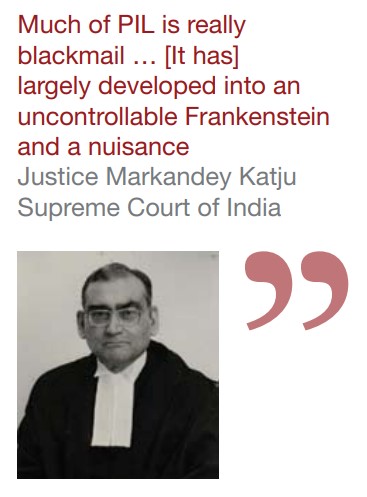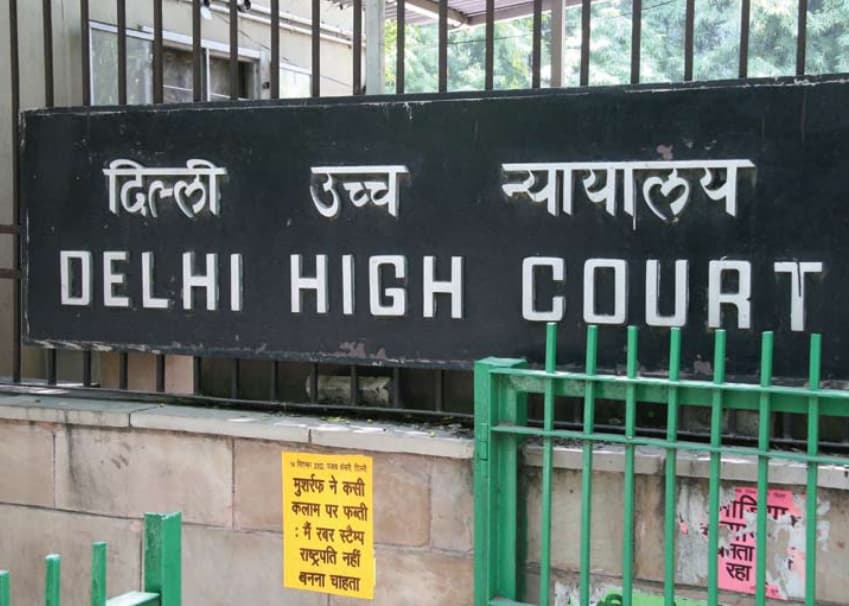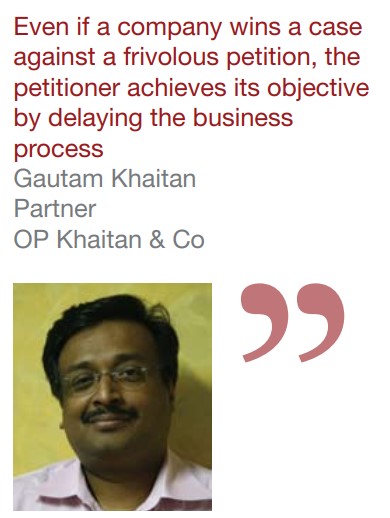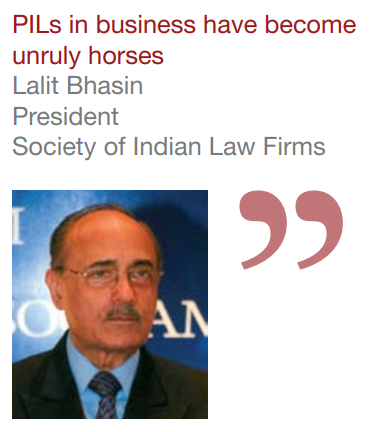The Indian judiciary is trying to tackle the problem of frivolous public interest litigations that are flooding the country’s overburdened courts and threatening the legitimate activities of domestic and international businesses
Raghavendra Verma reports from New Delhi
Reliance Power’s US$3 billion initial public offering (IPO) in January was the largest in India’s history. However, before being lapped up by investors, the offering had to overcome a potentially serious challenge in the form of a public interest litigation (PIL) filed by Grahak Suraksha Mandal, a Rajkot-based NGO.
It was only after a timely intervention by a Supreme Court bench headed by the chief justice of India that the challenge to the IPO was successfully overcome. Harish Salve, a senior counsel representing Reliance Power argued that the PIL was being used as a surrogate weapon to fight a corporate war, and to cause undue harassment to the company.
“PILs in business have become unruly horses,” says Lalit Bhasin, president of the Society of Indian Law Firms. “Day in and day out they are filed against proposed business ventures, infrastructure projects, mergers, de-mergers, and transfer of technology agreements.”
Launching a case
Though not defined in any of India’s statutes or acts, a PIL allows individuals to file petitions on issues that affect the public at large or on behalf of poor people who cannot afford to bring the case themselves. “Wherever there is a public interest involved with somebody’s rights being violated and something illegal going on, a PIL can be entertained”, says Prashant Bhushan, a senior counsel at the country’s Supreme Court.

Justice Katju’s views are shared by many in the profession. According to Gautam Khaitan of Delhi-based law firm OP Khaitan & Co, “most of the PILs in India are being misused by rival groups and people with vested interests.” Bhasin adds that many of these vested interests have involved competitors, disgruntled employees or suppliers that have had their contracts terminated.
The industries most exposed to PILs, according to Khaitan, are those which have to deal with the environment and natural resources; operate on a large scale with land bought from villagers; or employ a large labour force.

Public interest v public interest
In a bizarre twist, there has even been a PIL against PILs. Earlier this year, the International Bench and Bar Association filed a public interest litigation seeking judicial guidelines for entertaining pleas against projects of national importance that cost over Rs1 billion (US$25 million). It alleged that such PILs are usually filed close to the completion of the projects and result in an escalation of costs. The petition argued that, “the judiciary is saddled with unfounded fears based on unproven materials and media hype”.
For a long period of time, observers have emphasized the need for proper research and documentation to back up PILs, which all too often are based on little more than newspaper reports.
Bhasin says that such PILs can have a seriously negative impact on the business environment as they impede foreign direct investment and create a feeling of uncertainty and confusion, particularly relating to the establishment of new projects.

The Supreme Court has already framed certain guidelines to deal with the management and disposal of PILs, especially by the high courts where most of them are filed and admitted with a small fee of Rs50 (US$1.2). The lower courts are not allowed to entertain such petitions.
According to these guidelines, courts must be careful to determine whether the petitioner is bona fide or acting for personal gain, private profit, political motives or other oblique considerations. At times the Supreme Court has even fined petitioners for filing frivolous cases.
In June this year, the Delhi High Court imposed a fine of Rs10, 000 (US$250) on an Indian Airlines pilot who had filed a PIL regarding the safety of the Airbus A-320 aircraft’s emergency landing procedure. The court agreed with the airline’s argument that the pilot had moved the petition as a result of personal grievances against the airline and its other staff.
Fine examples of misuse
In a much more serious case that sat before the Supreme Court for three years, a petitioner was fined Rs100,000 (US$2,500) for ‘‘abusing the process of law’’ and ‘‘wasting enormous judicial time’’. Quashed in 2006, the PIL involved the lease of land for a coal washery project in Asia’s biggest open cast coal mine – Dipka-Gevra – situated in the state of Chhattisgarh. The petitioner, Deepak Agarwal, alleged that the permission granted to Maruti, the company planning to set up the new washery, was invalid as it involved the leasing of forest land.
However, the Supreme Court’s Central Empowered Committee (CEC) found that Agarwal, who claimed to be a “public-spirited person”, was in fact a name-lender to an existing coal washery company – Aryan Coal – which wanted to keep its potential competitor out of the market.
In spite of losing the case, Agarwal succeeded in delaying Maruti’s operations for several years. Aryan Coal escaped any indictment.

Khaitan wants the system to go even further in terms of filtering out frivolous petitions quickly. However in terms of whether to abolish PILs altogether, he firmly stands in favour of their existence. He argues that PILs offer “a very good means of keeping the judiciary and legislature in check [and ensuring that] the other general bodies of India do their duties”.
Khaitan himself was involved in a PIL in 2004 against the practice of smoking in public places. At the time, he recalls, “[the] government did not even argue the matter and told the court that there was no need to proceed with the litigation as it was passing a notification very shortly”.
Holding senior officials to account
Bhasin also agrees that parallel to the frivolous petitions, some citizens and “well-meaning NGOs” are also making a bona fide attempt through PILs to expose the misdeeds of people holding high positions.

Bhushan himself has been an active PIL lawyer and does not charge any fees for them. Further, he says that in some of his PILs, many other senior lawyers have appeared for free. In this regard he recalls the successful challenge to the privatization of Hindustan Petroleum, with the help of fellow senior counsel Fali Nariman.
Salve believes that PILs are vital in ensuring a level playing field for businesses. “When a business is involved in an illegal activity [it is good that] there are people around who blow a whistle through a PIL,” he says. Salve is nevertheless quick to highlight the risk of malicious litigations, adding that “anything can be misused or abused, and to take care of that there is appellate machinery”.
Bhushan agrees, stating that only those businesses engaged in illegal activities, or somehow trying to subvert the law, are at a genuine risk of facing a PIL. “If prima facie there is anything illegal involved in what is being challenged it will be admitted and a stay granted.”
Furthermore, Bhushan believes the courts have at times been very reticent in stopping illegal acts committed by businesses and are often inclined to throw out PILs against companies, even when illegal activities have taken place. “At times they are under influence or pressure of a company, or they simply take the decision based on the feeling that the PIL will hold up the business,” he notes.
He recalls a case brought against Reliance Communications, when its CDMA mobile phone service migrated to GSM without obtaining the necessary GSM licence from the government. “If any of the GSM dealers had filed a PIL or got a petition filed against the company, it would have been perfectly legitimate,” he says.
Bhushan also expresses disappointment at the green light given by the Supreme Court to Reliance Power’s IPO, a move he believes had many irregularities and was propped up and advertised in “a very dishonest manner”.
Keeping out of trouble

While the merits of public interest litigations as a means of serving the interests of the community at large and holding senior officials to account are beyond doubt, there is a significant danger that frivolous motions, or those with ulterior motives, could paralyze India’s already overburdened judiciary and cause undue delays to innocent parties. In 2004, the Supreme Court observed that “[Some people] try such litigations to keep themselves busy and their names in circulation, despite having really become defunct in actual public life and try to smear and smirch the solemnity of court proceedings.”
So what can a company do to protect itself from a malicious public interest litigation?
Bhasin suggests that in addition to obtaining the necessary permissions and sanctions to begin their business operations, companies should also seek a proper social audit from a responsible NGO, which certifies that the interests of the workers and residents in the areas are not in any way jeopardized and that the activities associated with the business will contribute to economic development. He also suggests a proper financial and legal audit to ensure that all compliances, including environmental requirements, are in place.
“These steps would go a long way towards minimizing PIL risks and would also enable the courts to throw out the frivolous PILs,” says Bhasin.
Salve has a more simple solution: “Just walk straight and narrow and there is no question of a PIL,” he says.



























